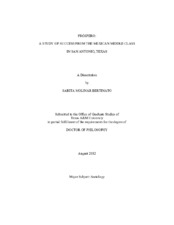| dc.description.abstract | Immigration is a topic that has experienced an evolution of social importance across centuries. While the United States has welcomed individuals seeking lives of promise and opportunity, its neighboring border with Mexico has also encouraged significant migration into the United States Therefore, immigration into Texas was not a new and unusual development. However, the flood of Mexican citizens trying to escape the regime of Porfirio Diaz was noteworthy and left San Antonio residents struggling to accept their new neighbors.
The purpose of this dissertation is to study a historically Mexican middle class neighborhood in San Antonio, in order to identify factors that made it possible for some residents to experience socioeconomic prosperity while others were less successful. I believe that positive socioeconomic success resulted from two important factors: high levels of human and social capital and the synergistic interactions of sociopolitical elements. I begin by presenting an overview of the shared turbulent history between Mexico and the United States, the rise and fall of President Porfirio Diaz, and the role that the Mexican Revolution played in San Antonio's 1910 immigration flux. Since this research focuses on the Mexican middle class, I explore the literature pertaining to racial/ethnic definitions, the middle class, and human/social capital, as well as the relevance of each concept within the context of my research question.
This research utilizes comparative/historical, qualitative, and quantitative methodologies. I present a quantitative analysis of Prospect Hill's residents, particularly those of an anomalous nature. Of the cases identified, I discuss the case of Romulo Munguia, a native-born Mexican who presented as the third anomalous Mexican resident. Munguia moved to the U.S. in 1926 and established himself as a successful, middle class printer who became heavily involved with San Antonio's Mexican community.
Ultimately, Munguia's success indicates a dependency on two specific factors. First, he possessed considerable human and social capital that afforded him social, economic, and political advantages. Secondly, he settled into a community that desperately needed his skills and expertise. Munguia's case supports the hypothesis that immigrant prosperity requires both human/social capital and specific synergistic interactions to achieve success. | en |


